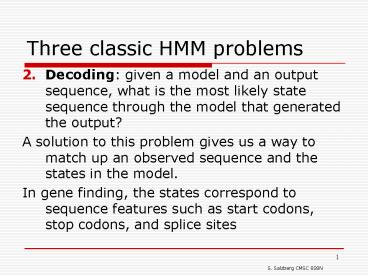Three classic HMM problems - PowerPoint PPT Presentation
1 / 25
Title:
Three classic HMM problems
Description:
1. S. Salzberg CMSC 828N. Three classic HMM problems ... A solution to this problem gives us a way to match up an observed sequence and ... Three classic HMM problems ... – PowerPoint PPT presentation
Number of Views:46
Avg rating:3.0/5.0
Title: Three classic HMM problems
1
Three classic HMM problems
- Decoding given a model and an output sequence,
what is the most likely state sequence through
the model that generated the output? - A solution to this problem gives us a way to
match up an observed sequence and the states in
the model. - In gene finding, the states correspond to
sequence features such as start codons, stop
codons, and splice sites
2
Three classic HMM problems
- Learning given a model and a set of observed
sequences, how do we set the models parameters
so that it has a high probability of generating
those sequences? - This is perhaps the most important, and most
difficult problem. - A solution to this problem allows us to determine
all the probabilities in an HMMs by using an
ensemble of training data
3
Viterbi algorithm
Where Vi(t) is the probability that the HMM is in
state i after generating the sequence y1,y2,,yt,
following the most probable path in the HMM
4
Our sample HMM
Let S1 be initial state, S2 be final state
5
A trellis for the Viterbi Algorithm
(0.6)(0.8)(1.0)
0.48
max
(0.1)(0.1)(0)
State
(0.4)(0.5)(1.0)
max
0.20
(0.9)(0.3)(0)
6
A trellis for the Viterbi Algorithm
(0.6)(0.8)(1.0)
(0.6)(0.2)(0.48)
0.48
.0576
max(.0576,.018) .0576
max
max
(0.1)(0.9)(0.2)
(0.1)(0.1)(0)
State
(0.4)(0.5)(1.0)
(0.4)(0.5)(0.48)
max
max
0.20
.126
max(.126,.096) .126
(0.9)(0.3)(0)
(0.9)(0.7)(0.2)
7
Learning in HMMs the E-M algorithm
- In order to learn the parameters in an empty
HMM, we need - The topology of the HMM
- Data - the more the better
- The learning algorithm is called
Estimate-Maximize or E-M - Also called the Forward-Backward algorithm
- Also called the Baum-Welch algorithm
8
An untrained HMM
9
Some HMM training data
- CACAACAAAACCCCCCACAA
- ACAACACACACACACACCAAAC
- CAACACACAAACCCC
- CAACCACCACACACACACCCCA
- CCCAAAACCCCAAAAACCC
- ACACAAAAAACCCAACACACAACA
- ACACAACCCCAAAACCACCAAAAA
10
Step 1 Guess all the probabilities
- We can start with random probabilities, the
learning algorithm will adjust them - If we can make good guesses, the results will
generally be better
11
Step 2 the Forward algorithm
- Reminder each box in the trellis contains a
value ?i(t) - ?i(t) is the probability that our HMM has
generated the sequence y1, y2, , yt and has
ended up in state i.
12
Reminder notations
- sequence of length T
- all sequences of length T
- Path of length T1 generates Y
- All paths
13
Step 3 the Backward algorithm
- Next we need to compute ?i(t) using a Backward
computation - ?i(t) is the probability that our HMM will
generate the rest of the sequence yt1,yt2, ,
yT beginning in state i
14
A trellis for the Backward Algorithm
Time
t0
t2
t3
t1
S1
(0.6)(0.2)(0.0)
0.0
0.2
State
(0.4)(0.5)(1.0)
(0.1)(0.9)(0)
S2
1.0
0.63
(0.9)(0.7)(1.0)
A
C
C
Output
15
A trellis for the Backward Algorithm (2)
Time
t0
t2
t3
t1
S1
(0.6)(0.2)(0.2)
.024 .126 .15
0.2
.15
0.0
State
(0.1)(0.9)(0.2)
(0.4)(0.5)(0.63)
S2
.397 .018 .415
0.63
.415
1.0
(0.9)(0.7)(0.63)
A
C
C
Output
16
A trellis for the Backward Algorithm (3)
Time
t0
t2
t3
t1
S1
(0.6)(0.8)(0.15)
.072 .083 .155
0.2
.15
0.0
.155
State
(0.1)(0.1)(0.15)
(0.4)(0.5)(0.415)
S2
.112 .0015 .1135
0.63
.415
1.0
.114
(0.9)(0.3)(0.415)
A
C
C
Output
17
Step 4 Re-estimate the probabilities
- After running the Forward and Backward algorithms
once, we can re-estimate all the probabilities in
the HMM - ?SF is the prob. that the HMM generated the
entire sequence - Nice property of E-M the value of ?SF never
decreases it converges to a local maximum - We can read off ? and ? values from Forward and
Backward trellises
18
Compute new transition probabilities
- ? is the probability of making transition i-j at
time t, given the observed output - ? is dependent on data, plus it only applies for
one time step otherwise it is just like aij(t)
19
What is gamma?
- Sum ? over all time steps, then we get the
expected number of times that the transition i-j
was made while generating the sequence Y
20
How many times did we leave i?
- Sum ? over all time steps and all states that can
follow i, then we get the expected number of
times that the transition i-x as made for any
state x
21
Recompute transition probability
In other words, probability of going from state i
to j is estimated by counting how often we took
it for our data (C1), and dividing that by how
often we went from i to other states (C2)
22
Recompute output probabilities
- Originally these were bij(k) values
- We need
- expected number of times that we made the
transition i-j and emitted the symbol k - The expected number of times that we made the
transition i-j
23
New estimate of bij(k)
24
Step 5 Go to step 2
- Step 2 is Forward Algorithm
- Repeat entire process until the probabilities
converge - Usually this is rapid, 10-15 iterations
- Estimate-Maximize because the algorithm first
estimates probabilities, then maximizes them
based on the data - Forward-Backward refers to the two
computationally intensive steps in the algorithm
25
Computing requirements
- Trellis has N nodes per column, where N is the
number of states - Trellis has S columns, where S is the length of
the sequence - Between each pair of columns, we create E edges,
one for each transition in the HMM - Total trellis size is approximately S(NE)































